
The A719 is a local road in Ayrshire, Scotland, connecting Girvan and the Ayrshire coastline with Glasgow via Ayr and Galston. Among other locations it passes the Trump Turnberry golf resort [1] and the hamlet of Moscow. [2]

The A719 is a local road in Ayrshire, Scotland, connecting Girvan and the Ayrshire coastline with Glasgow via Ayr and Galston. Among other locations it passes the Trump Turnberry golf resort [1] and the hamlet of Moscow. [2]
The road runs along the South Ayrshire coastline adjacent to the Firth of Clyde, and the East Ayrshire countryside. It connects Girvan to Glasgow via Maidens, Ayr, Galston, Turnberry, Kilmarnock, Waterside and Moscow. [2] The road starts and ends on the A77, a major road between Glasgow and Stranraer. The A719 runs parallel to the A77 for its length, and crosses it northeast of Ayr. [3]
The original route of the A719 was described by the Ministry of Transport in 1923 as "Milton – Pennyglen – Doonfoot – Ayr". [4] It was extended northeast from Ayr to the A77 north of Waterside in 1935. [5]

At the southern end of the A719, the road runs close to Turnberry Castle, believed to be birthplace of Robert the Bruce, and the Trump Turnberry golf resort. [6] The road runs through the centre of the Turnberry resort, with the hotel on one side and the course on the other. [7]
The A719 is famous for being the route of the Electric Brae between Drumshrang and Knoweside. A 0.25-mile (0.40 km) section of the road following the Croy Railway Viaduct presents an optical illusion to drivers, which makes viewers at the Brae believe vehicles can roll uphill. There is a stone marker describing the Brae at a point alongside the road. [8] [9]
In the centre of Ayr, the A719 crosses the River Ayr on the New Bridge, designed by Blyth and Cunningham and built between 1877 and 1879. The bridge is now Category B listed. It replaces an earlier bridge constructed by Alexander Stevens in 1789, which had become unsafe owing to flooding in 1877. [10] Between Galston and Moscow it crosses the River Irvine on a Category B listed bridge built in 1839. [11]

Ayrshire is a historic county and registration county in south-west Scotland, located on the shores of the Firth of Clyde. Its principal towns include Ayr, Kilmarnock and Irvine and it borders the counties of Renfrewshire and Lanarkshire to the north-east, Dumfriesshire to the south-east, and Kirkcudbrightshire and Wigtownshire to the south. Like many other counties of Scotland it currently has no administrative function, instead being sub-divided into the council areas of North Ayrshire, South Ayrshire and East Ayrshire. It has a population of approximately 366,800.
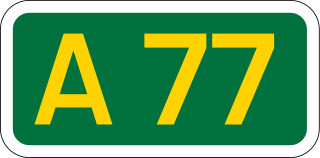
The A77 road is a major road in Scotland. It runs in a southwesterly direction from the city of Glasgow, past the towns of Giffnock, Newton Mearns, Kilmarnock, Prestwick, Ayr, Girvan and Stranraer to the village of Portpatrick on the Irish Sea. It passes through the council areas of Glasgow City, East Renfrewshire, East Ayrshire, South Ayrshire and Dumfries and Galloway.

Girvan is a burgh and harbour town in Carrick, South Ayrshire, Scotland. Girvan is situated on the east coast of the Firth of Clyde, with a population of about 6,450. It lies 21 miles (34 km) south of Ayr, and 29 miles (47 km) north of Stranraer, the main ferry port from Scotland to Northern Ireland.
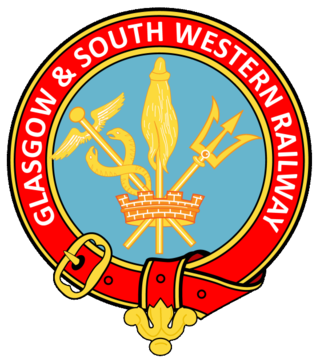
The Glasgow and South Western Railway (G&SWR) was a railway company in Scotland. It served a triangular area of south-west Scotland between Glasgow, Stranraer and Carlisle. It was formed on 28 October 1850 by the merger of two earlier railways, the Glasgow, Paisley, Kilmarnock and Ayr Railway and the Glasgow, Dumfries and Carlisle Railway. Already established in Ayrshire, it consolidated its position there and extended southwards, eventually reaching Stranraer. Its main business was mineral traffic, especially coal, and passengers, but its more southerly territory was very thinly populated and local traffic, passenger and goods, was limited, while operationally parts of its network were difficult.
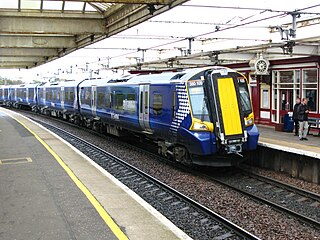
The Ayrshire Coast Line is one of the lines within the Strathclyde suburban rail network in Scotland. It has 26 stations and connects the Ayrshire coast to Glasgow. There are three branches, to Largs, Ardrossan Harbour and Ayr, all running into the high level at Glasgow Central.

Turnberry is a golf resort on the Firth of Clyde in Ayrshire, southwest Scotland. It comprises three links golf courses, a golf academy, a five-star James Miller-designed hotel from 1906, along with lodge and cottage accommodations.

The Glasgow South Western Line is a mainline railway in Scotland that runs from Glasgow to Kilmarnock, and then either Carlisle via Dumfries, or Stranraer via Ayr, with a branch to East Kilbride.

Barassie railway station is a railway station serving Barassie, South Ayrshire, Scotland. The station is managed by ScotRail and is on the Ayrshire Coast Line.

Ayr railway station serves the town of Ayr in South Ayrshire, Scotland. It is situated in Smith Street, off Burns Statue Square. The station, which is managed by ScotRail, is on the Ayrshire Coast Line, 41+1⁄2 miles (66.8 km) south-west of Glasgow Central.
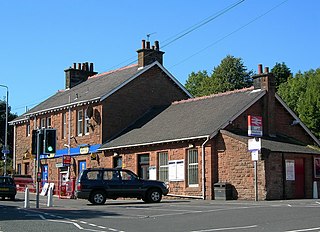
Maybole railway station is a railway station serving the town of Maybole, South Ayrshire, Scotland. The station is owned by Network Rail and managed by ScotRail and is on the Glasgow South Western Line.
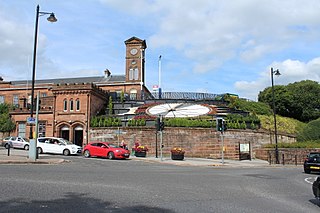
Kilmarnock railway station is a railway station in Kilmarnock, East Ayrshire, Scotland. The station is managed by ScotRail and is served by trains on the Glasgow South Western Line. One of the earliest railway stations in Scotland, the Kilmarnock and Troon Railway opened on 6 July 1812, until it was replaced by the Glasgow, Paisley, Kilmarnock and Ayr Railway on 4 April 1843.
The Maidens and Dunure Light Railway was a railway in Ayrshire, Scotland built to open up coastal communities by connecting them to the main line railway network.

The River Irvine is a river that flows through southwest Scotland. Its watershed is on the Lanarkshire border of Ayrshire at an altitude of 810 feet (250 m) above sea-level, near Loudoun Hill, Drumclog, and 7 miles SW by W of Strathaven. It flows 29+1⁄2 mi (47.5 km) westward, dividing the old district of Cunninghame from that of Kyle, until it reaches the sea via Irvine Harbour in the form of the Firth of Clyde, and flows into Irvine Bay by the town of Irvine. It has many tributaries, some of which form parish, district and other boundaries.
The Maybole and Girvan Junction Railway was a railway company that constructed a line between Maybole and Girvan. Although promoted independently, it was supported by the Glasgow and South Western Railway, and was seen as part of a trunk line connecting Glasgow with a ferry port for the north of Ireland.
The Darvel Branch was an extension of the former Glasgow, Paisley, Kilmarnock and Ayr Railway in Scotland built by the Glasgow and South Western Railway to allow trains to travel between Kilmarnock and Darvel.

The Roman Catholic Diocese of Galloway is an ecclesiastical territory or diocese of the Roman Catholic Church in Scotland. The pre-Reformation Diocese of Galloway, held to have been founded by St Ninian in the fifth century, had broken allegiance with Rome in 1560, and disappeared in 1689 in the (official) Church of Scotland but continued in the Episcopal Church of Scotland. The modern Roman Catholic diocese incorporates the local authority areas of Dumfries and Galloway, South Ayrshire, East Ayrshire and parts of North Ayrshire, (Cumbrae). The bishop's cathedra is at St Margaret's Cathedral, Ayr.

Waterside is a village in East Ayrshire, Scotland, situated about five miles north of Galston on the Craufurdland Water in the Parish of Fenwick. It lies a few miles north of Moscow on the A719 and had a population of 141 in the Census of 2001.
The Ayrshire Cup was an annual association football regional competition in Scotland. The cup competition was a knockout tournament between football clubs in the historic county of Ayrshire. The Ayrshire Cup was first held in 1877–78, with the first winners being Mauchline.

Turnberry Lighthouse. or Turnberry Point Lighthouse, is a category B listed minor light on the South Ayrshire coast of Scotland. It was designed by David and Thomas Stevenson and completed in 1873. It is a conspicuous landmark from the Ayrshire Coastal Path and the Trump Turnberry golf resort.